Marine Science News 2022
The Turtles are coming! The turtles are coming!
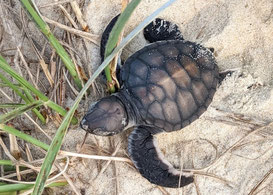
Some of our flippered friends are getting ready to come ashore and put their babies in the sands of the east coast in the hope that the warmer temperatures will incubate their eggs and birth the next generation of sea turtles.
Sea World and Watergum are very excited to announce the start of turtle nesting season on the Gold Coast and the beginning of TurtleWatch Gold Coast monitoring activities.
Turtle sightings are a common sight in the waters surrounding the Gold Coast but until recently, it was thought that nesting activities within the region were mainly confined to isolated beaches on South Stradbroke Island. However, in recent years turtle nesting activity has been occurring more and more frequently on the busy beaches of the Goal Coast.
Turtle hatchlings stranded
In March of 2020, beachgoers raised the alarm when they found Loggerhead turtle hatchlings stranded in the dunes on the Southern Gold Coast after they had lost their sense of direction in response to coastal light pollution. Since turtle hatchlings naturally use moonlight to guide them out to the ocean, bright city lights pose a threat to their survival as they draw the hatchlings inland instead. Thanks to the quick thinking of beachgoers that morning, the hatchlings were rescued and taken to Sea World where they were then successfully rehabilitated and released back into the ocean. Inspired by these actions, Watergum and Sea World joined forces to create the TurtleWatch Gold Coast program, a citizen science initiative that works together with the community to monitor turtle nesting activities.
Engaging the community

Sea World is a pioneer in marine animal rescue and rehabilitation and Watergum is a leader in community science, supporting member groups and individuals who are involved in hands-on restoration, maintenance and protection of the Gold Coast’s natural areas and species. Together, Watergum and Sea World are working to engage the community in monitoring and protecting these graceful marine animals and securing their survival for many generations to come.
Watergum’s TurtleWatch GC Coordinator Emily Vincent says that there is currently a data gap when it comes to turtle nesting activity on the Gold Coast. ‘This program is about engagement and awareness on marine turtles here on the Gold Coast and we need all the help we can get from the community.’
The program will teach the community how to identify turtles, their tracks and their nests so that you can log your sightings on our online database so we can ensure that Gold Coast turtles are protected.
Sightings are important
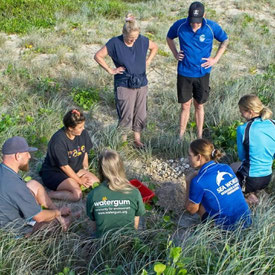
Sea World’s Siobhan Houlihan says that many people walk along the beach every day and witness turtle activity, sometimes without even realising it. ‘These sightings are important. We want to teach people what to do if they spot a sea turtle or identify turtle tracks on the beach. We will teach them how to recognise different species, how to identify different kinds of activity also what to do if they find an injured turtle.’
There are a number of sea turtle species visiting the Gold Coast, all are listed as Nationally vulnerable or endangered, with the eggs and hatchlings being particularly defenceless. Beach tractors, light pollution, construction work, and domestic animals are just some of the threats to sea turtle activity so we are calling out for regular beachgoers to help keep an eye on them.
Beach cleans
The groups have announced that this season they are conducting a series of beach cleans in collaboration with The Boardriders Foundation and Billabong. Billabong and The Boardriders Foundation aim to benefit and enhance the quality of life for communities across the world by supporting environmental, educational, science, water, wellness, and sustainability projects.
The beach cleanups are on Saturday mornings in November; Tugun on the 12th, Palm Beach on the 19th.
Full details and future beach clean events can be found on the Watergum website.
If you spot turtle activity please log it and notify Sea World on 07 5588 2222 and 07 5588 2177 after hours.
TurtleWatch GC Website: https://watergum.org/turtlewatch/
TurtleWatch GC Facebook Group: www.facebook.com/groups/771001743695227/ TurtleWatch GC
First published : https://www.echo.net.au/2022/11/the-turtles-are-coming-the-turtles-are-coming/
Copyright © 2022, The Echo
7 Nov 2022
Why do whales keep getting tangled in shark nets? And what should you do if you see it happen?
Australians have watched in horror this week as two separate humpback whales were tangled up in Queensland shark nets on the same day. These put the number of whales caught in Queensland shark nets to four this season – that we know about.
Worryingly, most humpback whales migrating north from Antarctica haven’t even passed Sydney yet. With more whales travelling to the warm Queensland breeding waters, this probably won’t be the last shark net entanglement we’ll hear about this year.
I’ve seen the reality of whale entanglement in shark nets firsthand, when I studied a humpback whale calf who died in a shark net a few years back. The animal autopsy (necropsy) conducted later confirmed the animal drowned. It was terrible.
So what are shark nets exactly, and how do they harm animals?
Shark nets don’t just harm sharks
Whale entanglement in fishing gear is a global problem. In some cases nets – combined with other human-made threats such as ship collisions – limit the recovery of some whale populations since whale hunting ceased, including the North Atlantic right whale.
Fortunately, the number of Australian humpback whales has been growing post-whaling. In fact, Australia’s east coast humpback whale population has an estimated 40,000 individuals.
The bad news is, more whales means more potential interactions with humans and our fishing gear, such as shark nets.
Shark nets are dotted around Queensland to try to minimise shark interactions with swimmers. These nets are anchored by chain to the seafloor and are designed to capture sharks before they swim too close to the beach.
But the nets offer little protection. For one, they’re typically between 124 and 186 metres long, 6 metres deep and don’t cover the entire beach, which means sharks can easily swim around and under them.
Indeed, despite the use of shark nets and other shark control equipment (such as drumlines), new data released today shows the number of shark bites in Australia have actually increased since 1791. Scientists caution that we are yet to understand why.
Sadly, shark nets usually kill the sharks that swim into them as they’re unable to move. And as we’ve seen this week, these nets do not discriminate. Other marine life – turtles, dolphins as well as whales – get caught up in this problem, too.
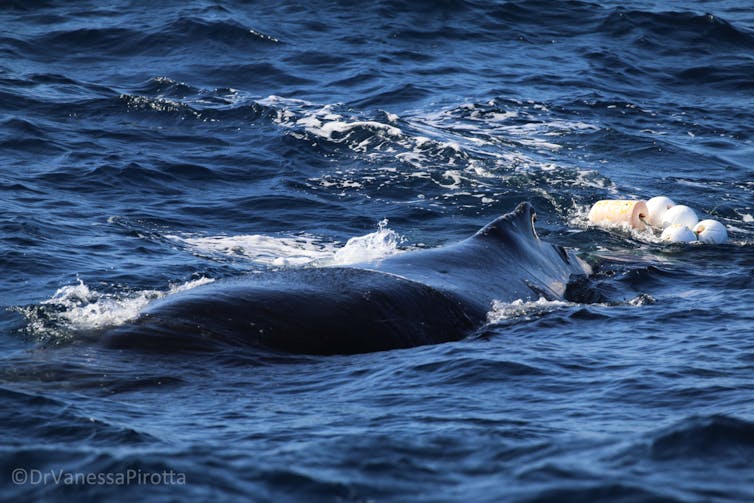
What happens when a whale is entangled?
We don’t exactly know why whales become entangled. Whales are extremely curious mammals and may investigate these dangers as they migrate, but get too close. Another reason may be that whales and other animals might simply not see the danger, and swim into it.
It’s not just shark nets, though. Whales in Australian waters get tangled up in a range of fishing gear – lobster and crab pots, longlines, gillnets and ghost nets (discarded or previously-used gear).
Whale entanglement can be an extremely stressful experience. Often, we see whales thrashing at the surface trying to free themselves. This can make the situation worse and limit their movement even further.
Depending on the entanglement and gear type, some whales may be unable to surface for air, and drown.
Alternatively, some whales might manage to get partially free, but suffer long-term consequences from dragging the nets and ropes, which can cut into their blubber.
Over time, these wounds can become infected, restrict the movement of the whale, or both. This leaves them vulnerable to predators such as killer whales and sharks, or unable to dive and dodge vessels.
Can we use technology to stop entanglements?
The reality is no one wants entanglements. Humans don’t want it to happen and I’m sure an entangled whale doesn’t enjoy the experience. It’s an unintended consequence of our attempts to protect swimmers.
So, what can we do about it? Stop swimming in the ocean? Remove the nets? Or is new technology our only answer?
Some suggest removing Queensland’s shark nets during winter when whales make their annual migration. This has yet to take place. What’s more, people often swim year-round in Queensland’s warm ocean waters.
In contrast, shark nets in New South Wales are removed during the winter to avoid the main part of whale migration. They’re deployed again later in the year, from September 1, which overlaps only with the southward migration back to Antarctica.
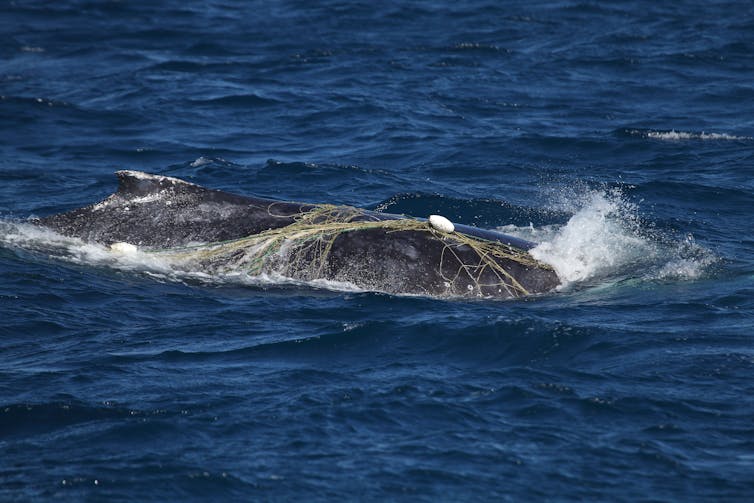
In the meantime, we can continue to trial other options. One is using SMART drumlines for a more targeted approach to capture and relocate sharks.
This is where a baited hook is placed on an anchor with two buoys and an attached satellite (GPS) technology unit. Once a shark takes the bait and is captured, authorities are alerted and can respond quickly to tag and relocate the animal offshore, away from the area of concern.
Scientists can then use shark movement data from the tag to learn more about shark habitat use.
While this isn’t a solution to whale entanglement, it does reduce the amount of netting in the water compared to shark nets. It’s also a much better option for sharks.
The Queensland government has invested in shark-control technology called “catch alert drumlines”, which are a type of SMART drumline. Trials of their use began in 2021.
Drone surveillance has also been a complimentary shark monitoring tool on Queensland beaches.
What should you do if you see an entangled whale?
Whale disentanglement should never be attempted by the general public.
Disentangling a whale requires trained personnel, specialised gear and trained vessel operators. Even experts with years of disentangling experience have been killed helping free whales from nets.
Whales are big. When they’re stressed and exhausted, they pose a serious threat to humans. Instead, if you see a whale caught in gear at the beach, tell the appropriate people about it immediately.
Authorities, such as the Queensland Government (The Department of Environment and Science) or The Sea World Foundation are key contacts in Queensland.
Other options include ORRCA (NSW based, with coverage in Queensland), which can relay important information to the people best placed to help. Social media can also be a powerful tool to alert authorities.
Queensland whale rescue crews also remain on standby during whale migration season and can deploy trained personnel to respond to entanglements swiftly, weather permitting.
As the whale migration continues north, lets hope these recent entanglements continue to prompt timely discussion about shark nets in Queensland waters.
![]()
Vanessa Pirotta, Postdoctoral Researcher and Wildlife Scientist, Macquarie University
7 July 2022
This article is republished from The Conversation under a Creative Commons license. Read the original article.
Millions of years ago, the megalodon ruled the oceans – why did it disappear?
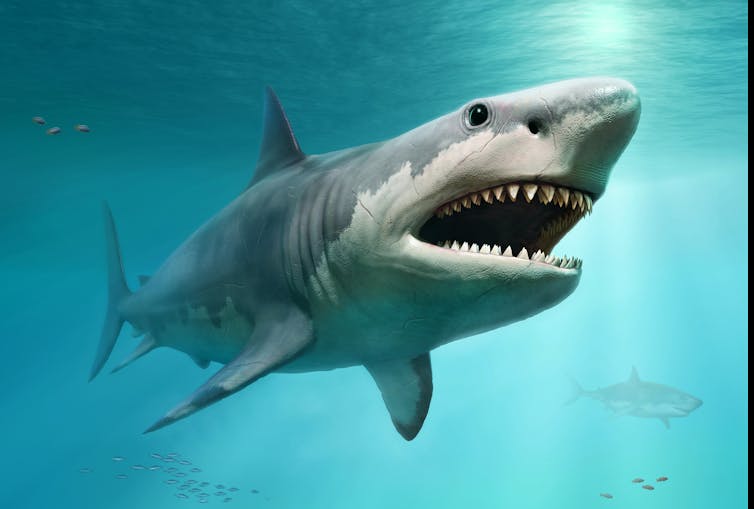
About the megalodon
As a scientist who studies sharks and other ocean species, I am fascinated by the awesome marine predators that have appeared and disappeared through the eons.
That includes huge swimming reptiles like ichthyosaurs, plesiosaurs and the mosasaurs. These incredible predators lived during the time of the dinosaurs; megalodon would not appear for another 50 million years.
But when it did arrive on the scene, about 15 million to 20 million years ago, the megalodon must have been an incredible sight.
A fully grown individual weighed about 50 metric tons – that’s more than 110,000 pounds (50,000 kilograms) – and was 50 to 60 feet long (15 to 18 meters). This animal was longer than a school bus and as heavy as a railroad car!
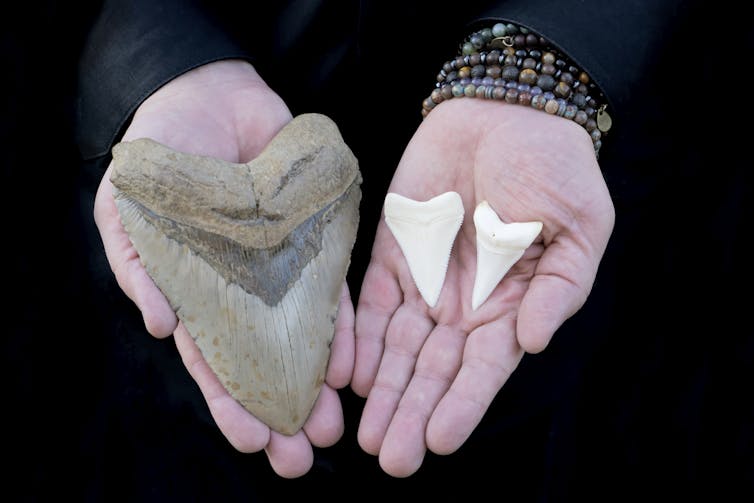
Its jaws were up to 10 feet (3 meters) wide, the teeth up to 7 inches (17.8 centimeters) long and the bite force was 40,000 pounds per square inch (2,800 kilograms per square centimeter).
Not surprisingly, megalodons ate big prey. Scientists know this because they’ve found chips of megalodon teeth embedded in the bones of large marine animals. On the menu, along with whales: large fish, seals, sea lions, dolphins and other sharks.
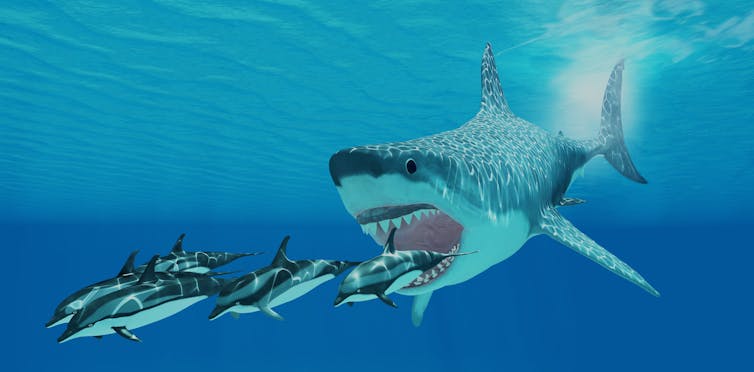
Are scientists sure megalodon is extinct?
Internet rumors persist that modern-day megalodons exist – that they still swim around in today’s oceans.
But that’s not true. Megalodons are extinct. They died out about 3.5 million years ago.
And scientists know this because, once again, they looked at the teeth. All sharks – including megalodons – produce and ultimately lose tens of thousands of teeth throughout their lives.
That means lots of those lost megalodon teeth are around as fossils. Some are found at the bottom of the ocean; others washed up on shore.
But nobody has ever found a megalodon tooth that’s less than 3.5 million years old. That’s one of the reasons scientists believe megalodon went extinct then.
What’s more, megalodons spent much of their time relatively close to shore, a place where they easily found prey.
So if megalodons still existed, people would certainly have seen them. They were way too big to miss; we would have lots of photographs and videos.
Why megalodon disappeared
It probably wasn’t one single thing that led to the extinction of this amazing megapredator, but a complex mix of challenges.
First, the climate dramatically changed. Global water temperature dropped; that reduced the area where megalodon, a warm-water shark, could thrive.
Second, because of the changing climate, entire species that megalodon preyed upon vanished forever.
At the same time, competitors helped push megalodon to extinction – that includes the great white shark. Even though they were only one-third the size of megalodons, the great whites probably ate some of the same prey.
Then there were killer sperm whales, a now-extinct type of sperm whale. They grew as large as megalodon and had even bigger teeth. They were also warmblooded; that meant they enjoyed an expanded habitat, because living in cold waters wasn’t a problem.
Killer sperm whales probably traveled in groups, so they had an advantage when encountering a megalodon, which probably hunted alone.
The cooling seas, the disappearance of prey and the competition – it was all too much for the megalodon.
And that’s why you’ll never find a modern-day megalodon tooth.
Michael Heithaus, Executive Dean of the College of Arts, Sciences & Education and Professor of Biological Sciences, Florida International University
20 June 2022
This article is republished from The Conversation under a Creative Commons license. Read the original article.
Animals sleep, but little is known about how sharks do it
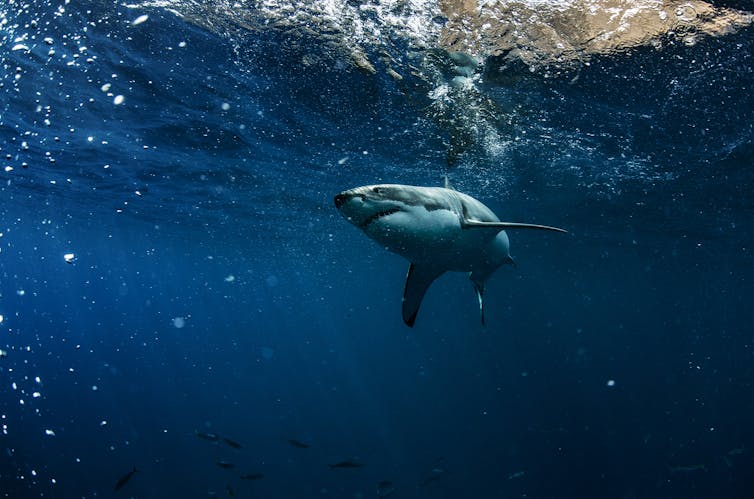
Sharks used to figure prominently in my nightmares: coming after me in the ocean, rivers, swimming pools. But after spending some time with these elusive creatures in 2015, a more compelling question started to keep me up at night — do the very creatures that invade my dreams engage in sleep themselves?
As the world’s leading — and only — authority in sleep in elasmobranchs (sharks and rays), my research team and I have begun to unravel this enigma, and our latest findings of physiological evidence of sleep in sharks are the most conclusive on the topic yet.
Circadian rhythms
Quiescence, or inactivity, is often the most basic behavioural characteristic that we associate with sleep. It was indeed this behaviour that my team set out to identify when we began our investigations into the presence of sleep in sharks. Specifically, we studied the presence of circadian-organized activity patterns, as sleep is controlled by the circadian clock (an internal, biochemical oscillator) in many animals.
Sharks are a unique group of vertebrates, however, as many species swim continuously to passively push oxygen-rich seawater over their gills — these are known as ram ventilators. Other species manually pump seawater over their gills while remaining motionless (buccal pumpers).
A study we conducted in 2020 found the presence of daily activity patterns in all the species investigated, buccal pumpers and ram ventilators alike. Importantly, these patterns were found to be internally regulated (circadian in nature) in buccal pumping species. This was a major discovery and a great step in the right direction, but were periods of inactivity indicative of sleep?
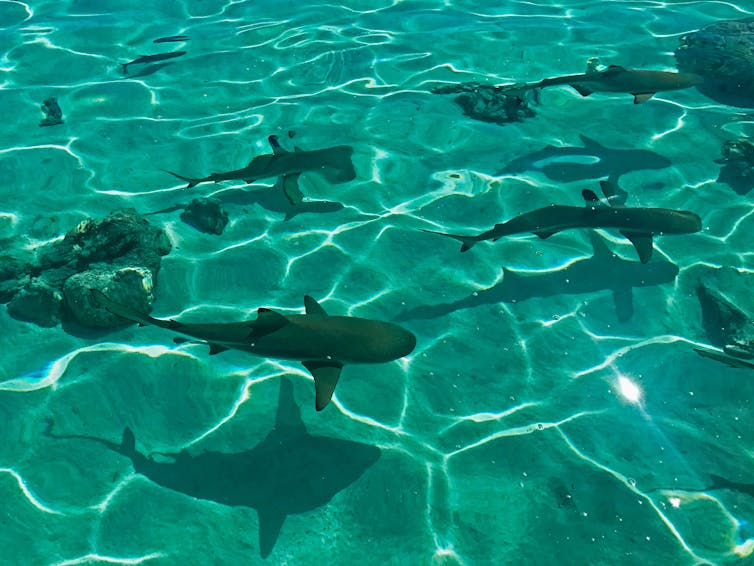
Sleep or quiet restfulness?
An animal’s responsiveness and awareness of external stimulation is reduced when asleep due to a sensory shutdown, or attenuation. As sleep researchers, we can exploit this ubiquitous sleep characteristic to behaviourally distinguish sleep from quiet restfulness.
Our 2021 study found that buccal pumping sharks were less responsive to mild electrical pulses following five minutes of inactivity. This became the criteria for our working definition of sleep in these animals.
Sleep is also internally regulated, so that animals can recover lost sleep by sleeping more. This characteristic was absent in the sharks in our study — they did not make up sleep following periods of sleep deprivation. This phenomenon is also >absent during sleep in other marine fishes.
These somewhat conflicting results highlight an important point: behaviour can be deceptive and misleading. Animals can appear to be asleep while being awake and >vice versa. Sadly, behaviour alone is often not enough to reliably identify sleep in animals.
The physiology of shark sleep
To conclusively verify our working definition of sleep in buccal pumping sharks (more than five minutes of inactivity is sleep), my team set out to find physiological evidence of sleep that aligned with what we had seen behaviourally.
To do this, we recorded changes in metabolic rates in New Zealand’s draughtsboard shark via recordings of oxygen consumption over a 24-hour period. A drop in metabolic rate during sleep has been reported in many animals and is considered a reliable physiological indicator of sleep.
We also recorded subtle behaviours associated with sleep in other animals, such as eye state (open/closed) and body posture (upright/flat). We found there to be no significant difference in metabolic rates between swimming sharks and sharks engaging in periods of inactivity that lasted less than five minutes.
When sharks were inactive for five minutes or longer, however, metabolic rates dropped dramatically. This physiological change was also accompanied by a conspicuous shift in posture, with sharks transitioning from an upright position (sitting up on their pectoral fins) to a completely recumbent position. Eye state, however, was found to be unrelated to the sharks’ state of consciousness, as the animals were often observed sleeping with eyes open.
Taken together, these data are the most conclusive evidence for sleep in sharks and verify our previous behavioural findings.
Moving forward
Sleep has been found in all animals studied to date, stretching as far back on the evolutionary scale as and jellyfish. As the earliest living, jawed vertebrates, sharks play an important role in helping us understanding the evolutionary history of sleep in vertebrates.
Our research has come a long way in uncovering the previously unanswered question of sleep in sharks, but we have only touched the tip of the iceberg. Now that we know that (at least some) sharks do indeed sleep, the next question to answer is how they sleep.
Nothing is known about sleep in ram ventilating sharks. Their need for constant swimming to facilitate gas exchange suggests they have likely evolved interesting adaptations to permit sleep under
this unusual lifestyle. Our group is now conducting electrophysiological studies of brain activity that will provide comprehensive insight into the form that sleep takes in these animals.
![]()
Michael Liam Kelly, Postdoctoral research fellow, Neuroscience, Simon Fraser University
April 7 2022
This article is republished from The Conversation under a Creative Commons license. Read the original article.
Sculptures headed for Great Barrier Reef display

Artworks that will be the newest additions to a north Queensland underwater museum can be viewed on land. The Museum of Underwater Art (MOUA) has launched its next series of sculptures at a special exhibit at Townsville’s Museum of Tropical Queensland.
The Ocean Sentinels above the surface exhibit allows locals and visitors to enjoy the five artworks before they begin to transform into their own micro reefs when placed on the Great Barrier Reef.
MOUA Board Director Paul Victory said the exhibit was about connecting with as many people as possible and to spark meaningful conversation around the Great Barrier Reef and its future.
“The chance to see the world-class sculptures in the flesh and learn about their stories, promoting reef conservation and the link between art and science to a wider audience, is incredible,” Mr Victory said.
“This unique exhibit allows the public to enjoy and experience the next stage of the Museum of Underwater Art and learn about the important work we've been doing with coral planting, reef health surveys, providing education and work opportunities for Indigenous guides, and more.”

Sculptures celebrate scientists
World-renowned artist Jason deCaires Taylor designed and created the sculptures that celebrate the work of eight marine scientists and community members, who have been influential in our understanding of reef protection.
“I hope that in years to come a variety of endemic species such as corals, sponges and hydroids will change the sculptures' appearance in vibrant and unpredictable ways,” Mr deCaires Taylor said.
“Like the Great Barrier Reef itself, they will become a living and evolving part of the ecosystem, emphasising both its fragility and its endurance.”It is envisaged the new sculptures will be installed by June 2022 with the final location to be decided by the Great Barrier Reef Marine Park Authority.
The pieces will be installed in shallow depths, providing the perfect experience for snorkellers to get up close to the sculptures, broadening MOUA's offering to a larger group of people, who are more inclined to snorkel.
From the UK to Townsville
The pandemic meant Mr deCaires Taylor had to create them in his United Kingdom studio.The artworks were carefully shipped to Townsville where a selection were installed in the Museum of Tropical Queensland for display until 15 May.
Queensland Museum Network CEO Dr Jim Thompson said it was a wonderful collaboration between the Museum of Tropical Queensland and the Museum of Underwater Art to produce this unique display.
“These sculptures are destined for the ocean, so for people to see them in the museum and learn about them before they are installed underwater is something really special,” Dr Thompson said.
The Museum of Underwater Art exhibits include Ocean Siren, off Townsville’s The Strand, and Coral Greenhouse at John Brewer Reef, which can be visited by booking a trip with one of the approved commercial tourism operators.
18 March 2022
Original article:
https://www.racq.com.au/articles/out-and-about/2022/3/sculptures-headed-for-great-barrier-reef-display
What causes a tsunami? An ocean scientist explains the physics of these destructive waves

On Jan. 15, 2022, the Hunga Tonga-Hunga Ha’apai volcano in Tonga erupted, sending a tsunami racing across the Pacific Ocean in all directions.
As word of the eruption spread, government agencies on surrounding islands and in places as far away as New Zealand, Japan and even the U.S. West Coast issued tsunami warnings. Only about 12 hours after the initial eruption, tsunami waves a few feet tall hit California shorelines – more than 5,000 miles away from the eruption.
I’m a physical oceanographer who studies waves and turbulent mixing in the ocean. Tsunamis are one of my favorite topics to teach my students because the physics of how they move through oceans is so simple and elegant.
Waves that are a few feet tall hitting a beach in California might not sound like the destructive waves the term calls to mind, nor what you see in footage of tragic tsunamis from the past. But tsunamis are not normal waves, no matter the size. So how are tsunamis different from other ocean waves? What generates them? How do they travel so fast? And why are they so destructive?
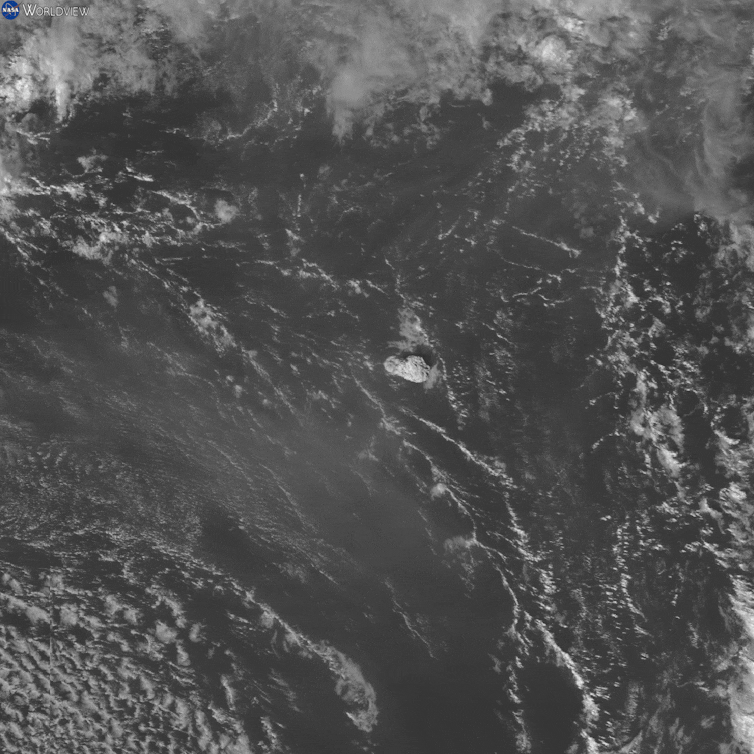
Deep displacement
Most waves are generated by wind as it blows over the ocean’s surface, transferring energy to and displacing the water. This process creates the waves you see at the beach every day.
Tsunamis are created by an entirely different mechanism. When an underwater earthquake, volcanic eruption or landslide displaces a large amount of water, that energy has to go somewhere – so it generates a series of waves. Unlike wind-driven waves where the energy is confined to the upper layer of the ocean, the energy in a series of tsunami waves extends throughout the entire depth of the ocean. Additionally, a lot more water is displaced than in a wind-driven wave.
Imagine the difference in the waves that are created if you were to blow on the surface of a swimming pool compared to the waves that are created when someone jumps in with a big cannonball dive. The cannonball dive displaces a lot more water than blowing on the surface, so it creates a much bigger set of waves.
Earthquakes can easily move huge amounts of water and cause dangerous tsunamis. Same with large undersea landslides. In the case of the Tonga tsunami, the massive explosion of the volcano displaced the water. Some scientists are speculating that the eruption also caused an undersea landslide that contributed to the large amount of displaced water. Future research will help confirm whether this is true or not.
Tsunami waves travel fast
No matter the cause of a tsunami, after the water is displaced, waves propagate outward in all directions – similarly to when a stone is thrown into a serene pond.
Because the energy in tsunami waves reaches all the way to the bottom of the ocean, the depth of the sea floor is the primary factor that determines how fast they move. Calculating the speed of a tsunami is actually quite simple. You just multiply the depth of the ocean – 13,000 feet (4,000 meters) on average – by gravity and take the square root. Doing this, you get an average speed of about 440 miles per hour (700 kilometers per hour). This is much faster than the speed of typical waves, which can range from about 10 to 30 mph (15 to 50 kph).
This equation is what oceanographers use to estimate when a tsunami will reach faraway shores. The tsunami on Jan. 15 hit Santa Cruz, California, 12 hours and 12 minutes after the initial eruption in Tonga. Santa Cruz is 5,280 miles (8,528 kilometers) from Tonga, which means that the tsunami traveled at 433 mph (697 kph) – nearly identical to the speed estimate calculated using the ocean’s average depth.
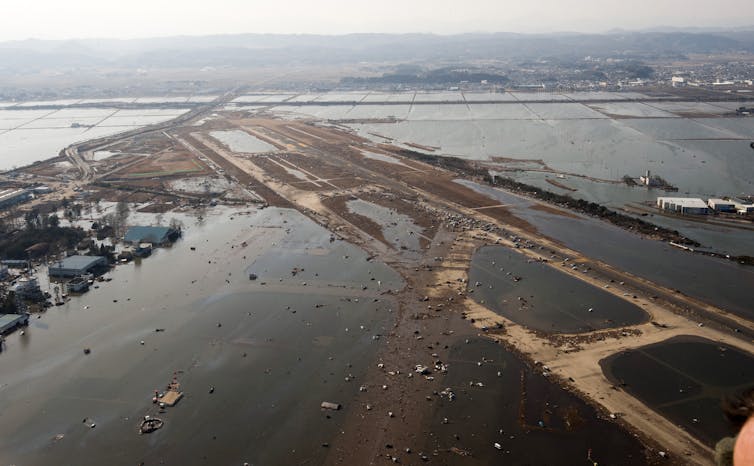
Destruction on land
Tsunamis are rare compared to ubiquitous wind-driven waves, but they are often much more destructive. The 2004 Indian Ocean tsunami killed 225,000 people. More than 20,000 lost their lives in the 2011 Japan tsunami.
What makes tsunamis so much more destructive than normal waves?
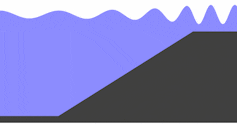
In the open ocean, tsunami waves can be small and may even be undetectable by a boat at the surface. But as the tsunami approaches land, the ocean gets progressively shallower and all the wave energy that extended thousands of feet to the bottom of the deep ocean gets compressed. The displaced water needs to go somewhere. The only place to go is up, so the waves get taller and taller as they approach shore.
When tsunamis get to shore, they often do not crest and break like a typical ocean wave. Instead, they are more like a large wall of water that can inundate land near the coast. It is as if sea level were to suddenly rise by a few feet or more. This can cause flooding and very strong currents that can easily sweep people, cars and buildings away.
Luckily, tsunamis are rare and not nearly as much of a surprise as they once were. There is now an extensive array of bottom pressure sensors, called DART buoys, that can sense a tsunami wave and allow government agencies to send warnings prior to the arrival of the tsunami.
If you live near a coast – especially on the Pacific Ocean where the vast majority of tsunamis occur – be sure to know your tsunami escape route for getting to higher ground, and listen to tsunami warnings if you receive one.
The eruption of the Hunga Tonga-Hunga Ha’apai volcano severed the main communication cable that connects the people of Tonga to the rest of the world. While the science of tsunamis can be
fascinating, these are serious natural disasters. Only a few deaths have been reported so far from Tonga, but many people are missing
and the true extent of the damage from the tsunami is still unknown.![]()
Sally Warner, Assistant Professor of Climate Science, Brandeis University
January 19 2022
This article is republished from The Conversation under a Creative Commons license. Read the original article.
Sponges can survive low oxygen and warming waters. They could be the main reef organisms in the future
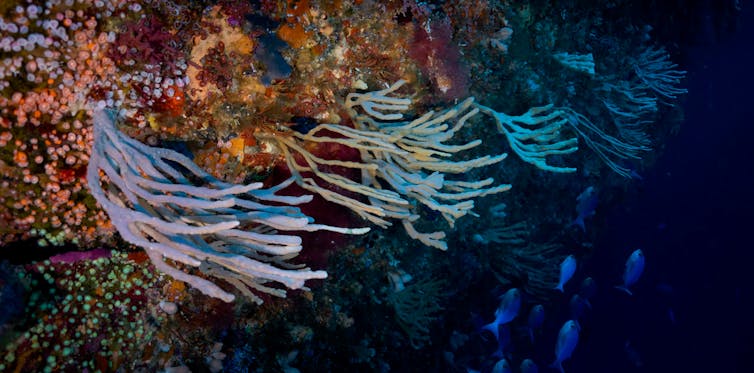 Valerio Micaroni
Valerio Micaroni
Sponges are ancient marine animals, very common throughout the world’s oceans and seem less affected by ocean warming and acidification.
Our latest research shows they can also survive low levels of oxygen.
This is a surprising finding because most sponges are rarely exposed naturally to low oxygen in modern seas.
We propose their tolerance is the result of their long evolutionary history and exposure to variable oxygen concentrations through geological time.
As our oceans continue to warm due to climate change, they are expected to hold less oxygen.
The ability of sponges to survive low-oxygen conditions means they are likely to tolerate these possible future environments better than other organisms living on the seafloor.

There are an estimated 8000-plus sponge species in the oceans. They are multicellular organisms with a body architecture built around a system of water canals, pores and channels allowing water to be pumped and circulated through them.
Their specialised pumping and feeding cells, called choanocytes, are highly efficient. Sponges can pump the equivalent of their own body volume in a matter of seconds.
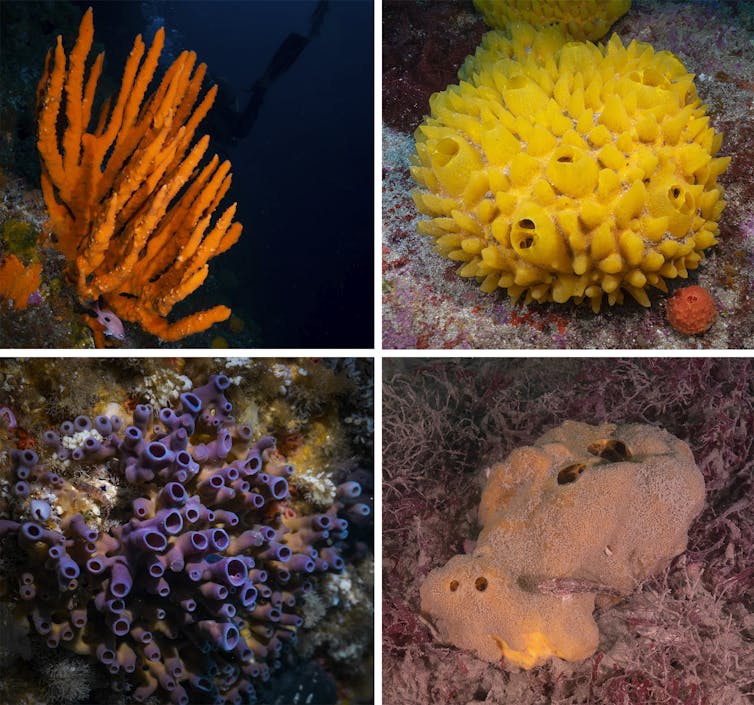
In modern oceans, sponges are often the most abundant organisms in rocky reef environments. They fulfil important ecological functions as part of bottom-dwelling (benthic) communities worldwide.
Sponges have many roles in marine ecosystems, but their water-processing ability and efficiency at capturing small particles is the most important because it links the water column with the seafloor. Sponges also support diverse seafloor communities by transforming carbon.
Some sponge species have been shown to be very tolerant to climate change stressors, particularly changing temperature and acidity (measured as pH). This means sponges could be future winners in changing oceans.
Sponges in past oceans
We know that sponges are ancient organisms, but recently described 890-million-year-old fossils have turned our understanding of evolution on its head.
Most major animal groups, including arthropods and worms, first appear in the fossil record during a period known as the Cambrian explosion, 540 million years ago. But if the newly-described fossils are indeed sponges, they would have existed nearly 300 million years earlier, significantly pushing back the date of Earth’s earliest known animals.
If the ancestors of modern sponges are about 900 million years old, they would have evolved and survived during the Marinoan glaciation, 657-645 million years ago, when the oceans were extremely low in oxygen.
They would have also likely experienced wide fluctuations in other environmental conditions such as pH, temperature and salinity through evolutionary time.
Sponge tolerance to low oxygen
Our recent environmental tolerance experiments support this scenario, showing they are surprisingly tolerant to low levels of oxygen.
We assessed the response of sponges to moderate and severe low-oxygen events in a series of laboratory experiments on four species from the northeast Atlantic and southwest Pacific. Sponges were exposed to a total of five low-oxygen treatments, with increasing severity (40%, 20%, 6%, 5% and 1.5% air saturation) over seven to 12 days.
We found the sponges generally very tolerant of hypoxia. All but one of the species survived in the extreme experimental conditions, and that species only began to die off at the lowest oxygen concentration. In most experiments, hypoxic conditions did not significantly affect the sponges’ respiration rates, which suggests they can take up oxygen at very low concentrations in the surrounding environment.
As a response to the low oxygen, sponges displayed a number of shape and structural changes, likely maximising their ability to take up oxygen at these low levels.
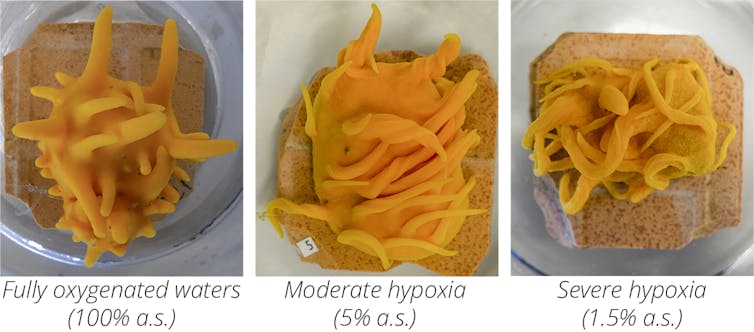
Sponges in future oceans
Warmer ocean water holds less oxygen, and ocean deoxygenation is one of the major consequences of climate change.
Warmer water also becomes more buoyant than cooler water, which reduces the mixing of surface oxygenated water with deeper layers that naturally contain less oxygen. At the same time, warmer temperatures increase the demand of organisms for oxygen as metabolic rates increase and stress responses are initiated.
While oxygen levels in the ocean are only expected to fall on average by 4% across all oceans, these effects are likely to be much more extreme locally and regionally. In coastal waters, climate-driven ocean deoxygenation can be exacerbated by a process called eutrophication, essentially an increase in nutrients. This fuels plankton blooms, and when bacteria breakdown the dead phytoplankton, they use up all the oxygen.
Since the land is generally the source of these excess nutrients, shallow coastal areas are most at risk. These are areas where rocky reefs are typically dominated by sponges, particularly just below the depth of light penetration (typically 20-30m).
Our finding lends further support to the idea that sponges will be the survivors if our oceans continue to warm.
![]()
James Bell, Professor of Marine Biology, Te Herenga Waka — Victoria University of Wellington; Rob McAllen, Professor of Marine Conservation, University College Cork, and Valerio Micaroni, PhD Candidate in Coastal and Marine Biology and Ecology, Te Herenga Waka — Victoria University of Wellington
January 17 2022
This article is republished from The Conversation under a Creative Commons license. Read the original article.
Tsunami reported broadly across the Southwest Pacific and on the East coast of Australia.
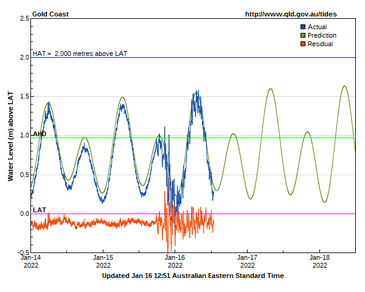
A wide spread Tsunami wave has been recorded by tide gauges From Cooktown in far north Queensland to Spring Bay in Southern Tasmania. The Tsunami was generated by an undersea volcanic eruption in Tonga in the southern Pacific ocean.
The Tsunami height recorded at the Gold Coast in Queensland reached 0.82 m at 22:54 (AEST). in the plot to the right the red line is the residual when tide levels are removed. the highest wave height was not the first wave but recorded hours later.
| Site | Time (AEST) | Tsunami height | |
|
Nuku'Alofa, Tonga |
21.10S 175.20W | 15:46 | 1.19 m |
|
Suva, Fiji |
18.10S 178.42E | 17:03 | 0.36 m |
|
Pago Pago, Samoa |
14.30S 170.69W | 16:40 | 0.55 m |
|
Apia, Samoa |
13.67S 171.83W | 18:06 | 0.27 m |
|
Rarotonga, Cook Islands |
21.20S 159.78W | 19:56 | 0.74 m |
|
Funafuti, Tuvalu |
8.50S 179.20E | 18:24 | 0.11 m |
|
East Cape, NZ |
37.50S 178.17E | 19:15 | 0.38 m |
|
Lifou Island, New Caledonia |
20.90S 167.28E | 17:33 | 0.29 m |
| Ouinne, New Caledonia | 22.00S 166.83E | 19:21 | 0.67 m |
| Norfolk Island, Australia | 29.10S 167.95E | 21:00 | 1.27 m |
| Port Villa, Vanuatu | 17.80S 168.31E | 19:50 | 1.18 m |
| Luganville, Vanuatu | 15.50S 167.33E | 19:06 | 0.29 m |
| DART 55023, Coral Sea 2, | 14.72S 153.54E | 21:44 | Detected |
| Gold Coast, Australia | 27.90S 153.43E | 22:54 | 0.82 m |
| Charleston, NZ | 41.83S 171.33E | 23:35 | 0.65 m |
| Port Kembla, Australia | 34.50S 151.00E | 02:50 | 0.65 m |
| Twofold Bay, Australia | 37.00S 150.00E | 23:30 | 0.77 m |
| Spring Bay, Australia | 42.50S 147.93E | 21:00 | 0.27 m |
| Rosslyn Bay, Australia | 23.20S 150.79E | 03:05 | 0.25 m |
| Jackson Bay, NZ | 43.97S 168.62E | 23:50 | 1.14 m |
| Coffs Harbour, Australia | 0.30S 153.15E | 10:30 | 0.43 m |
| Lord Howe Island, Australia | 31.52S 159.06E | 08:00 | 0.50 m |
| Eden, Australia | 37.07S 149.91E | 10:15 | 0.40 m |
What is the value of a wave? How changes to our coastline could wipe out surfing’s benefits
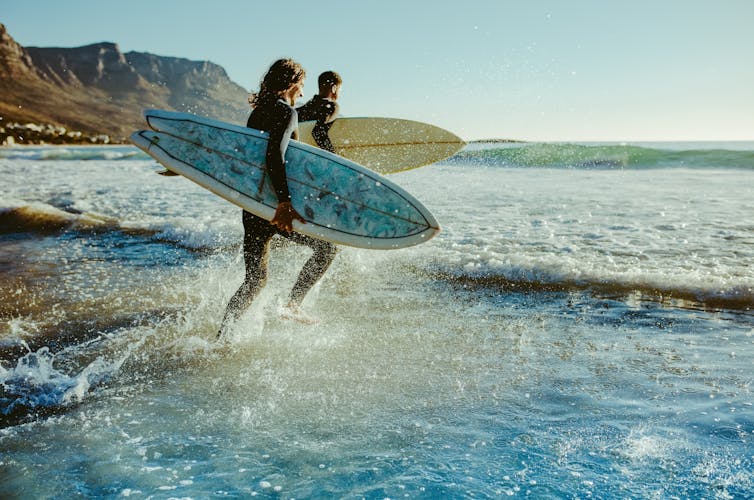
Before COVID-19, global surf tourism spending was estimated at up to A$91 billion per year. And since the start of the pandemic, demand for surfing has boomed as people increasingly turn to outdoor activities. But surfing’s benefits to human well-being aren’t often studied in economics terms. This is a major knowledge gap we are now trying to fill. Such research is important. Changes to the coastline such as from sea walls and groynes can dramatically reduce the quality of surfing waves. But the consequences of coastal developments on surfing are often poorly understood and rarely quantified before projects start. It’s crucial we understand the real value of surfing, before we lose the myriad of benefits they bring – not only to Australia’s 1.2 million active surfers, but to hundreds of coastal towns where surfing underpins the local economy and lifestyle.
Surfing economics
There are many studies on the economic value of Australian beach pastimes such as fishing, swimming and diving. But not for surfing. Internationally, we know surfing is a major direct contributor to the economy of wave-rich places. However, until recently, the value of surfing to human well-being has been largely unaccounted for.

This is despite recent evidence pointing to surfing’s positive social and health outcomes, including among war veterans and children with chronic illnesses.
Surfing Economics is an emerging field of research that documents and quantifies the total economic value of surfing. This can include, for example, increased house prices near good quality breaks, or social welfare benefits people derive from visiting surf beaches.
Building on the few previous surfing economics studies in Australia, our research aims to calculate the total economic value of surfing.
Our forthcoming study on the Noosa World Surf reserve, so far, demonstrates that the local economic contribution of surfing is in the order of hundreds of millions of dollars. This in terms of surfers’ welfare, as well as direct spending on surf gear and travel.
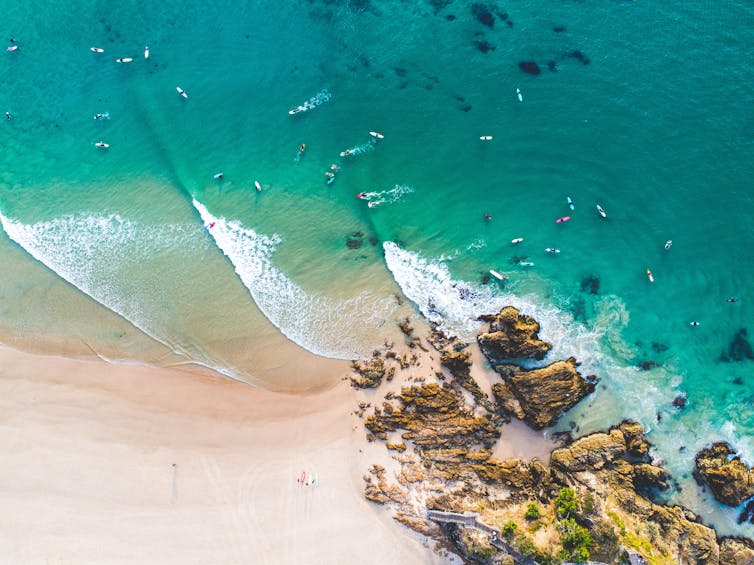
Overseas, the economic contribution is a little clearer. A 2017 study used satellite imagery to demonstrate that economic activity grows faster near good-quality surf breaks, particularly in developing countries such as Indonesia and Brazil.
In the UK alone, the overall annual impact of surfing on the national economy is calculated at up to £5 billion (over A$9 billion).
How coastal projects make or break waves
Swell waves are typically formed by winds blowing many kilometres offshore. It’s perhaps easy to think that this natural,distant origin means there’s nothing we can do about the formation of waves.
But the truth is surfing waves are the product of complex interactions between waves, tides, currents, wind and the shape of the seabed. Shallow coral reefs, headlands and sand banks are responsible for making highly sought-after waves.
By directly or indirectly impacting any of these factors, wave quality has been changed for better – or for worse.
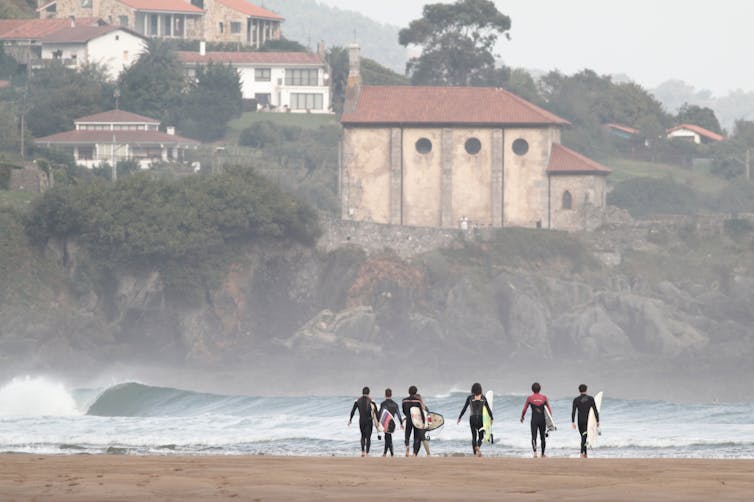
The world-renowned Mundaka wave, in northern Spain, temporally disappeared because dredging of the nearby rivermouth changed ocean dynamics. This resulted in a decline in economic activity and the cancellation of the Billabong Pro World Championship in 2005 and 2006.
In the Portuguese island of Madeira, the construction of a rock-wall severely disrupted the formation of the Jardim do Mar wave in 2005, and a fall in local economic growth rates followed. In Peru, the extension of a fishing pier negatively impacted Cabo Blanco, one of Peru’s best barrelling waves, by shortening its length.
Closer to home, the Ocean Reef Marina, currently under construction in Perth’s north, will significantly impact three local surf breaks. About 1.5 kilometres of mostly unmodified beaches are being redeveloped into a brand new marina.
Studies have shown that well planned coastal management interventions can dramatically increase benefits to surfers and non-surfers alike.
One of the most iconic examples is the “Superbank” at Snapper Rocks in the Gold Coast. There, a world class wave forms thanks to river sediment being relocated through the Tweed Sand Bypassing Project.

The project is costly to operate and has impacted nearby beaches. But its expenses are outweighed by improvements to surf quality and beach amenity, which underpin the local economy and the nature-based, active lifestyle the Gold Coast is famous for.
Giving waves legal protection
Building on efforts nearly 40 years ago to protect Victoria’s iconic Bells Beach wave, Peru and New Zealand have granted statutory protection to their surf breaks under environmental protection laws.
In practice, this means threats to surf breaks by coastal activities, such as sewage discharges or building offshore structures, must be avoided or mitigated.
Similar recognition and valuation of surfing resources is necessary and would be highly beneficial for Australia.
A rigorous, science-based evaluation of surfing’s total economic value could serve to inform cost-benefit analysis of coastal management programs. These may include fighting erosion to protect the coastline, or building artificial surf reefs.
In these uncertain times of COVID-19, many of us cannot yet travel far away. But with 85% of Australians living by the coast, many of us can still catch a wave at our doorstep – and that is
priceless.![]()
Ana Manero, Research Fellow, Australian National University; Alaya Spencer-Cotton, Research assistant, The University of Western Australia; Javier Leon, Senior lecturer, University of the Sunshine Coast, and Neil Lazarow, Senior Research Consultant, CSIRO
January 10 2022
This article is republished from The Conversation under a Creative Commons license. Read the original article.

 Marine Science Australia
Marine Science Australia